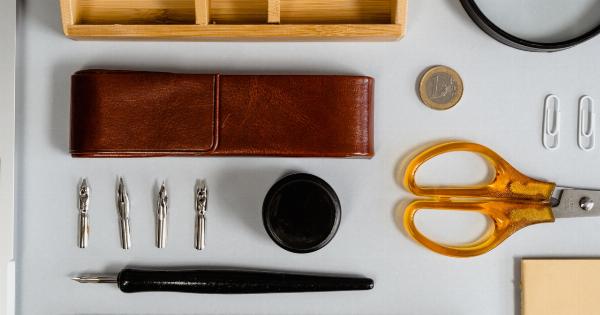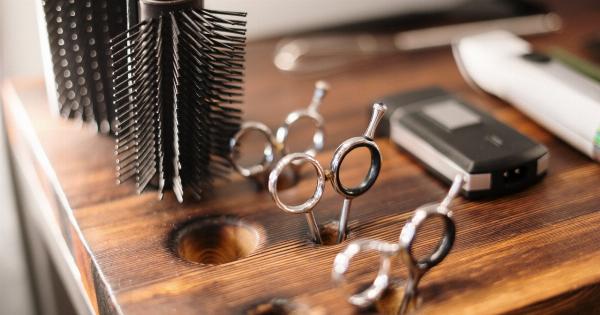When it comes to cutting our hair, most of us trust professional hairdressers or barbers to do the job. However, there are times when we attempt to trim our own hair at home or even help a friend or family member with their haircut.
In these situations, it is important to take precautions and prevent hair scissor injuries. Accidents can happen, and the last thing you want is to hurt yourself or someone else while wielding a pair of scissors.
In this article, we will discuss techniques to prevent hair scissor injuries and ensure a safe and successful haircutting experience.
Invest in High-Quality Scissors
One of the first steps in preventing hair scissor injuries is to invest in a pair of high-quality scissors. Cheap or dull scissors can cause hair to snag or pull, leading to potential accidents.
Look for hairdressing scissors made from high-quality stainless steel, as they are durable and provide a smooth cutting experience. Additionally, ensure that the blades of the scissors are sharp and regularly maintained.
Choose the Right Scissor Size
Another important aspect to prevent hair scissor injuries is selecting the appropriate scissor size. Scissors that are too small can slip from your grasp, leading to accidental cuts.
On the other hand, scissors that are too large can be difficult to maneuver, increasing the risk of injuring yourself or others. The ideal scissor size will vary depending on your hand size and the type of haircut you are attempting. Consult with a professional or try different scissor sizes to find the perfect fit for you.
Maintain Proper Holding and Cutting Technique
Using the correct holding and cutting technique is crucial in minimizing hair scissor injuries. Hold the scissors with your thumb in one hole and three other fingers in the other hole, ensuring a firm grip.
Never hold the scissors with just your thumb and index finger, as this can lead to control issues and potential accidents.
When cutting the hair, keep your wrist straight and avoid excessive bending or twisting. Use your fingers to control the movement of the scissors, and avoid making sudden or jerky motions.
This will help maintain precision and reduce the risk of accidental cuts.
Keep Scissors Away from the Face
It is essential to keep the scissors away from the face while cutting hair. Accidentally poking or cutting the delicate skin on the face can cause serious injuries and infections.
When cutting around the ears or the nape of the neck, be extra cautious and avoid any sudden movement that could harm the person’s skin. Use your fingers as a guide to prevent the scissors from coming in direct contact with the skin.
Work in a Well-Lit Area
Proper lighting is essential to prevent hair scissor injuries. Working in a dimly lit area can make it difficult to see the hair clearly, increasing the chances of accidents.
Ensure that you have access to sufficient overhead lighting or use a table lamp to illuminate the area where you are cutting. This will allow you to see the details of the hair and make precise cuts safely.
Take Regular Breaks
Fatigue can impair your focus and increase the likelihood of accidents. When attempting a haircut, make sure to take regular breaks to rest your hand and relax your muscles.
Sitting or standing in the same position for an extended period can lead to muscle strain, which can affect your control while handling the scissors. Taking short breaks will help you stay alert and maintain a steady hand throughout the haircutting process.
Use Mirrors for Assistance
When cutting your own hair or helping someone else, mirrors can be extremely helpful. Place a large mirror in front of you and use a smaller handheld mirror to see the back of your head.
This will provide a better perspective and allow you to make more accurate cuts. If possible, have a second person present to assist you by holding the mirror or providing guidance.
Be Mindful of Hair Accessories
Hair accessories such as clips, elastics, or headbands can pose a risk if not handled properly. Ensure that all accessories are securely fastened and properly positioned before you begin cutting.
Be cautious while removing or adjusting hair accessories during the haircutting process to avoid injuring yourself or the person you are helping. Taking a moment to double-check the stability of hair accessories can prevent accidents and ensure a smooth and safe haircutting experience.
Keep Children and Pets Away
When cutting hair at home, it is important to keep children and pets away from the cutting area. Excited or distracted children or playful pets can cause sudden movements or distractions, increasing the likelihood of accidents.
Designate a separate room or area where children and pets can safely play or rest while you focus on the haircutting process without any potential interruptions or accidents.
Know When to Seek Professional Help
While it is great to be able to cut your own hair or help others, it is crucial to know your limitations. If you encounter a complicated hairstyle or a situation where you feel unsure or uncomfortable, do not hesitate to seek professional help.
Hairdressers and barbers undergo extensive training and have the expertise to perform intricate cuts safely. Remember, your safety and the safety of others should always be the top priority.
Conclusion
Hair scissor injuries can be easily prevented by following a few simple techniques.
Investing in high-quality scissors, selecting the right scissor size, and maintaining proper holding and cutting techniques are essential for a safe and successful haircutting experience. Keep the scissors away from the face, work in a well-lit area, and take regular breaks to avoid fatigue. Utilize mirrors and be mindful of hair accessories during the haircutting process.
Finally, keep children and pets away from the cutting area and know when to seek professional help if needed. By following these techniques, you can enjoy a risk-free haircutting experience and maintain the beauty and health of your hair.






























